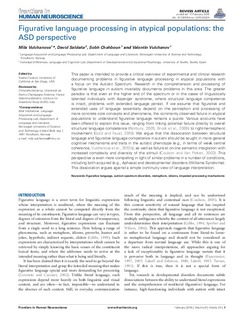| dc.contributor.author | Vulchanova, Mila Dimitrova | |
| dc.contributor.author | Saldaña, David | |
| dc.contributor.author | Chahboun, Sobh | |
| dc.contributor.author | Vulchanov, Valentin | |
| dc.date.accessioned | 2015-04-20T07:06:36Z | |
| dc.date.accessioned | 2016-06-15T08:17:21Z | |
| dc.date.available | 2015-04-20T07:06:36Z | |
| dc.date.available | 2016-06-15T08:17:21Z | |
| dc.date.issued | 2015-02-17 | |
| dc.identifier.citation | Frontiers in Human Neuroscience 2015 | nb_NO |
| dc.identifier.issn | 1662-5161 | |
| dc.identifier.uri | http://hdl.handle.net/11250/2392606 | |
| dc.description.abstract | This paper is intended to provide a critical overview of experimental and clinical research
documenting problems in figurative language processing in atypical populations with
a focus on the Autistic Spectrum. Research in the comprehension and processing of
figurative language in autism invariably documents problems in this area. The greater
paradox is that even at the higher end of the spectrum or in the cases of linguistically
talented individuals with Asperger syndrome, where structural language competence
is intact, problems with extended language persist. If we assume that figurative and
extended uses of language essentially depend on the perception and processing of
more concrete core concepts and phenomena, the commonly observed failure in atypical
populations to understand figurative language remains a puzzle. Various accounts have
been offered to explain this issue, ranging from linking potential failure directly to overall
structural language competence (Norbury, 2005; Brock et al., 2008) to right-hemispheric
involvement (Gold and Faust, 2010). We argue that the dissociation between structural
language and figurative language competence in autism should be sought in more general
cognitive mechanisms and traits in the autistic phenotype (e.g., in terms of weak central
coherence, Vulchanova et al., 2012b), as well as failure at on-line semantic integration with
increased complexity and diversity of the stimuli (Coulson and Van Petten, 2002). This
perspective is even more compelling in light of similar problems in a number of conditions,
including both acquired (e.g., Aphasia) and developmental disorders (Williams Syndrome).
This dissociation argues against a simple continuity view of language interpretation. | nb_NO |
| dc.language.iso | eng | nb_NO |
| dc.publisher | Frontiers Media | nb_NO |
| dc.rights | Navngivelse 3.0 Norge | * |
| dc.rights.uri | http://creativecommons.org/licenses/by/3.0/no/ | * |
| dc.title | Figurative language processing in atypical populations: The ASD perspective | nb_NO |
| dc.type | Journal article | nb_NO |
| dc.type | Peer reviewed | nb_NO |
| dc.date.updated | 2015-04-20T07:06:36Z | |
| dc.source.volume | 9 | nb_NO |
| dc.source.journal | Frontiers in Human Neuroscience | nb_NO |
| dc.identifier.doi | 10.3389/fnhum.2015.00024 | |
| dc.identifier.cristin | 1195434 | |
| dc.description.localcode | Copyright © 2015 Vulchanova, Saldaña, Chahboun and Vulchanov. This is an open-access article distributed under the terms of the Creative Commons Attribution License (CC BY). The use, distribution and reproduction in other forums is permitted, provided the original author(s) or licensor are credited and that the original publication in this journal is cited, in accordance with accepted academic practice. No use, distribution or reproduction is permitted which does not comply with these terms. | nb_NO |

